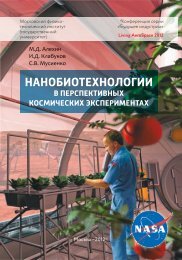Foundations for Molecular and Enzymatic Functional Surgery
This paper presents an approach of molecular and enzymatic surgery for treatment of human diseases, including opportunity for use of systemic biology methods in planning of surgical interventions, possible biological components of a “molecular scalpel”, and problems of standardization, medical ethics and clinical trials of the new pharma-surgical toolbox. In conclusions is proposed to consider of molecular and enzymatic surgery methods as realization of the principles of “functional surgery” and also further development of fast track surgery with attaining the modern concept of a personalized approach to surgical treatment of the patient.
This paper presents an approach of molecular and enzymatic surgery for treatment of human diseases, including opportunity for use of systemic biology methods in planning of surgical interventions, possible biological components of a “molecular scalpel”, and problems of standardization, medical ethics and clinical trials of the new pharma-surgical toolbox. In conclusions is proposed to consider of molecular and enzymatic surgery methods as realization of the principles of “functional surgery” and also further development of fast track surgery with attaining the modern concept of a personalized approach to surgical treatment of the patient.
Create successful ePaper yourself
Turn your PDF publications into a flip-book with our unique Google optimized e-Paper software.
Clinical trials <strong>and</strong> training of “surgical team 2.0” will differ from the corresponding<br />
procedures when using of existing drugs <strong>and</strong> medical products. The tissue-tropic of the used agents<br />
will dem<strong>and</strong> development of adequate physiological models (<strong>for</strong> example, based on humanized<br />
animals) [21] <strong>and</strong> creation of life-like st<strong>and</strong>s <strong>for</strong> surgical skills training [22]. The problem of clinical<br />
interpretation of multi-OMICS data is common of the training of medicals <strong>and</strong> is discussed now<br />
[23].<br />
Problems with st<strong>and</strong>ardization can be considered both methods <strong>for</strong> unification of<br />
bioconstruction set/kit elements [24] <strong>and</strong> through st<strong>and</strong>ardized practice procedures like a Good<br />
Laboratory (GLP), Manufacturing (GMP) <strong>and</strong> Tissue (GTP) Practices, including <strong>for</strong> st<strong>and</strong>ardized<br />
manufacturing of viral [25] <strong>and</strong> cellular products [26]. Formalization <strong>and</strong> st<strong>and</strong>ardization those<br />
mechanisms are devoted an amount of initiatives in the <strong>for</strong>m of consortiums, organizations,<br />
committees <strong>and</strong> working groups (Tab. 3).<br />
Table 3. Initiatives <strong>for</strong> Advanced Therapies St<strong>and</strong>ardization.<br />
Initiative Description Ref.<br />
St<strong>and</strong>ards<br />
Coordinating Body<br />
For Cellular/Gene<br />
<strong>and</strong> Regenerative<br />
Therapies <strong>and</strong> Cell-<br />
Based Drug<br />
Discovery (USA,<br />
2016)<br />
Synthetic Biology<br />
Open Language<br />
Developer’s Group<br />
(USA, 2011)<br />
Protein Capture<br />
Reagents Program<br />
(USA, 2006)<br />
iGEM Foundation<br />
(Registry of<br />
St<strong>and</strong>ard Biological<br />
Parts) (USA, 2002)<br />
Good Laboratory<br />
<strong>and</strong> Manufacturing<br />
Practices<br />
Committees (WHO,<br />
1967)<br />
American Type<br />
Culture Collection<br />
– ATCC (USA,<br />
1925)<br />
Promoting the development of new st<strong>and</strong>ards in manufacturing <strong>and</strong><br />
processing <strong>and</strong> coordinating international st<strong>and</strong>ard-development<br />
ef<strong>for</strong>ts; <strong>for</strong>mulation of global regulatory convergence initiatives;<br />
clarification of the surrounding regulatory treatment of different<br />
human cell <strong>and</strong> tissue products by FDA; initiatives to improve<br />
existing regulatory pathways to support rapid evaluation of<br />
regenerative medicine <strong>and</strong> cell <strong>and</strong> gene therapy products.<br />
The Synthetic Biology Open Language (SBOL) can be used to<br />
represent genetic designs through a st<strong>and</strong>ardized vocabulary of<br />
schematic glyphs (SBOL Visual) as well as a st<strong>and</strong>ardized digital<br />
<strong>for</strong>mat (SBOL Data).<br />
NIH program <strong>for</strong> producing of st<strong>and</strong>ardized binding reagents <strong>for</strong><br />
research uses, including recombinant monoclonal antibodies,<br />
recombinant antibodies, aptamers (nucleic-acid-based reagent),<br />
non-antibody binding reagents.<br />
The iGEM Registry has over 20,000 documented parts <strong>for</strong> genetic<br />
construction engineering based on biobricks. The Catalog organizes<br />
many of these parts by part type, chassis, function, <strong>and</strong> more.<br />
The establish of quality system of management controls to ensure<br />
the uni<strong>for</strong>mity, consistency, reliability, reproducibility, quality, <strong>and</strong><br />
integrity of chemical (including pharmaceuticals) non-clinical<br />
safety tests (GLP), <strong>and</strong> quality control management of<br />
manufacturing (GMP) include hygiene, validation, self-inspection,<br />
personnel, premises, equipment, materials <strong>and</strong> documentation.<br />
The acquisition, authentication, production, preservation,<br />
development <strong>and</strong> distribution of st<strong>and</strong>ard reference<br />
microorganisms, cell lines <strong>and</strong> other materials <strong>for</strong> research <strong>and</strong><br />
development. Collection contains of st<strong>and</strong>ard eukaryotic <strong>and</strong><br />
prokaryotic cells, virus strains, etc. as research models <strong>and</strong> chassis<br />
(established, emerging <strong>and</strong> potential).<br />
[27]<br />
[28]<br />
[29]<br />
[30]<br />
[31]<br />
[32]












